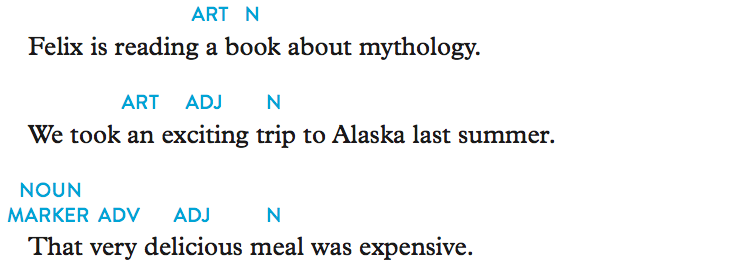29a. Articles and other noun markers
Standard English uses noun markers to help identify the nouns that follow. In addition to articles (a, an, and the), noun markers include the following:
- possessive nouns, such as Elena’s (See 36a.)
- possessive pronoun/adjectives: my, your, his, her, its, our, their (See 46b.)
- demonstrative pronoun/adjectives: this, that, these, those (See 46b.)
- quantifiers: all, any, each, either, every, few, many, more, most, much, neither, several, some, and so on (See 29d.)
- numbers: one, twenty-three, and so on
Using articles and other noun markers
Articles and other noun markers always appear before nouns; sometimes other modifiers, such as adjectives and adverbs, come between a noun marker and a noun.

In most cases, do not use an article with another noun marker.

Expressions like a few, the most, and all the are exceptions: a few potatoes, all the rain. See also 29d.
Types of articles and types of nouns
To choose an appropriate article for a noun, you must first determine whether the noun is common or proper, count or noncount, singular or plural, and specific or general. The following chart describes the types of nouns.
Articles are classified as indefinite and definite. The indefinite articles, a and an, are used with general nouns. The definite article, the, is used with specific nouns. (The last section of the chart below explains general and specific nouns.)
A and an both mean “one” or “one among many.” Use a be-fore a consonant sound: a banana, a vacation, a happy child, a united family. Use an before a vowel sound: an eggplant, an uncle, an honorable person. (See also a, an in the glossary of usage.)
The shows that a noun is specific; use the with one or more than one specific thing: the newspaper, the soldiers.
- Multilingual/ESL > Exercises: 28–11 to 28–13
- Multilingual/ESL > LearningCurve: Verbs for multilingual writers
Types of nouns
Common or proper
| Common nouns | Examples | ||||||
|---|---|---|---|---|---|---|---|
|
|
| Proper nouns | Examples | ||||||||
|---|---|---|---|---|---|---|---|---|---|
|
|
Count or noncount (common nouns only)
| Count nouns | Examples | ||||
|---|---|---|---|---|---|
|
|
| Noncount nouns | Examples | ||||||
|---|---|---|---|---|---|---|---|
|
|
note: See the chart on page 383 for lists of commonly used noncount nouns.
Singular or plural (both common and proper)
| Singular nouns (count and noncount) | Examples | ||||||||
|---|---|---|---|---|---|---|---|---|---|
|
|
| Plural nouns (count only) | Examples | ||||||
|---|---|---|---|---|---|---|---|
|
|
Specific (definite) or general (indefinite) (count and noncount)
| Specific nouns | Examples | |||
|---|---|---|---|---|
|
|
| General nouns | Examples | |||
|---|---|---|---|---|
|
|